Abstract
The effective solution of social and legislative tasks of information openness of educational institutions leading role played by purposeful information policy, which develops and implements each educational organization. One of the problems that preventing effective solution is a limited vision of the leaders and teachers of the tasks of information openness. It is limited by the need to perform only the state requirements to the official website of the educational institutions in the practice of the majority of educational institutions. This situation is explained by the fact that in the minds of the majority of directors and teachers has not formed a new mental model of the system for educational institutions public information activities. It occupies a special place information policy, are guided first and foremost on the needs of developing social and professional needs in a variety of information on the activities of schools, kindergartens, children's supplementary education institutions, etc. The paper presents an approach, that changes the prevailing practice in the vision system in which the backbone element are not state requirements for transparency, and integrated information policy connected with the objectives of informing on the activities of educational organizations, transparency (including state requirements) and information cultures. Highlighting information policy as a system-forming element, identified five major directions. Following these directions in every educational organization can be formed and implemented an integrated information policy that raises public information activities of educational organizations to a new level.
Keywords: Educational organizationinformation opennessinformation policy
Introduction
Developing the social needs of public information about the activities of educational institutions in the Russian Federation and state requirements for information openness have identified the need to create new institutions for education of public information activities on the Internet and choose the direction of their information policy.
For the establishment and successful implementation of the new activity necessary methodological and technological support, and above all the development of the methodological foundations of the design and purpose of this new activity in educational institutions.
This article continues the series development of methodological bases of the public information activities of educational institutions from the perspective of system-activity approach (Asmolova, 2019).
Problem Statement
Despite advances in solving legally assigned tasks of information openness of educational institutions (Federal law FZ-273 of 29.12.2012) and the implementation of state requirements for the provision of publicly available official information about the educational organization (The order of Federal service for supervision of education and science of 29.05.2014 No. 785), the formation of new educational institutions for public information activities and the development of its own information policy caused great difficulties.
This situation is due to lack of sufficient representation of the elements and their relationships in the system of public information activities of educational institutions.
Among these elements at this stage in the development of new activities include: informational openness as a state requirement for activity of the educational organization, the official information about the educational organization's and official website, in which each educational institution is obliged to provide the regulatory required information in the public domain (figure
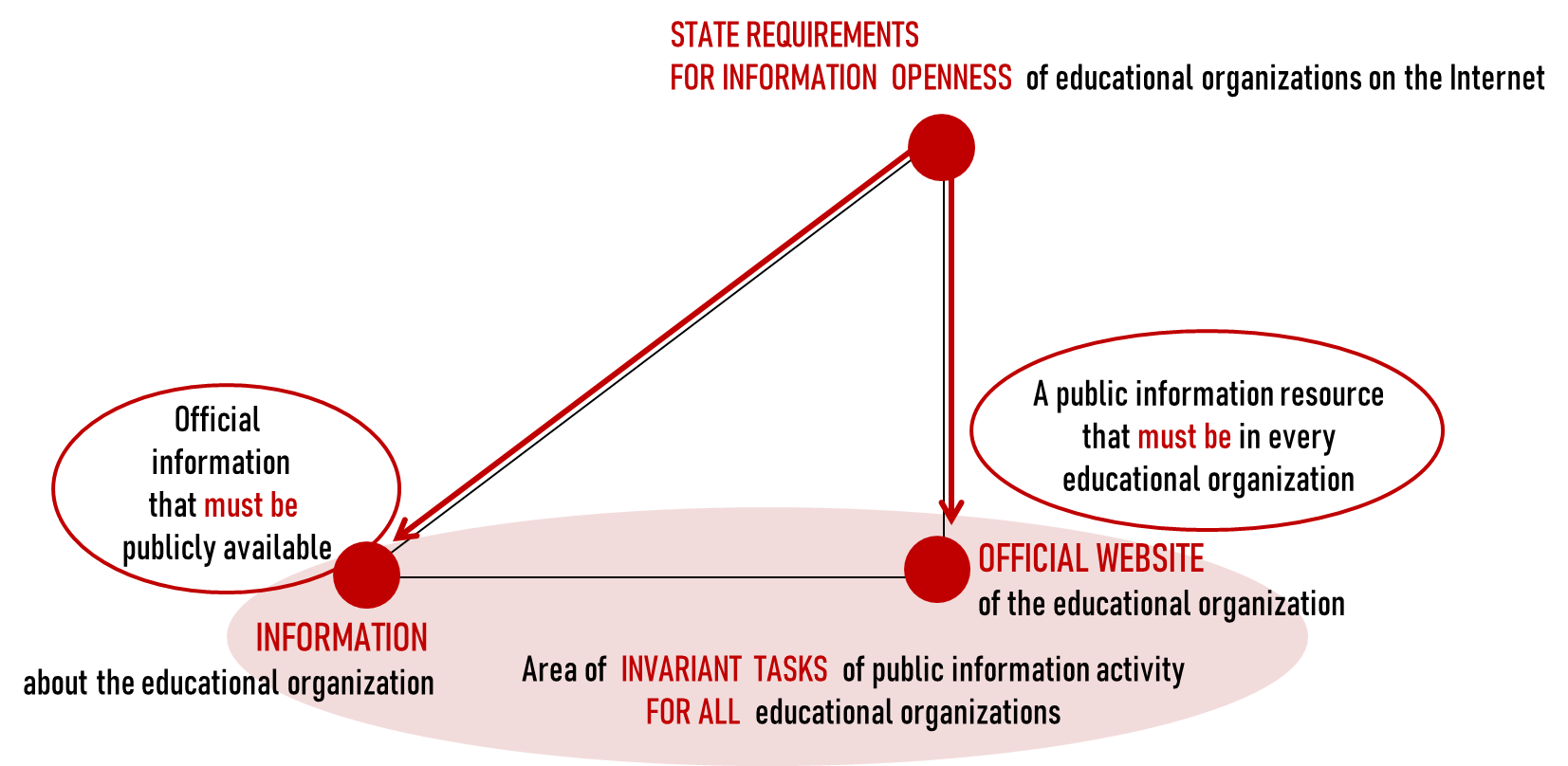
As seen from the scheme, in the practice of educational institutions formed such a system of public information activities, in which there is no element, forming information policy educational organization. This situation leads to the fact, that the information policy of the educational institutions is reduced to the solution of the invariant for all educational organizations performing tasks of public claims to having their official websites of regulatory required information.
This mental model (O'Konnor & McDermott, 2006) for solving the problem of information transparency and a limited vision of the system of public information activities becomes a factor, hindering the development of educational opportunities organizations in solving problems of expansion of its openness and the development strategy of its representation on the Internet, relying on the growing social needs for public information and social dialogue in the field of education.
Research Questions
Thus, as the main research questions are the issues related to the change in presentation of the system of public information activities of educational institutions, focused only on the decision of problems of invariant information openness (Asmolova & Ovchinnikova, 2019).
As a hypothesis put forward the position that the inclusion of information policy element will expand the targets of the system of public information activities of educational institutions, complementing their variative directions. Implementation directions will contribute to the presentation of the specifics and peculiarities of each educational activity organization, represented by its distinctive "individual persons" in the flow of information about the educational institutions.
Determination of the necessary and sufficient number of elements included in the public information activities of educational institutions, is the next research question. This is related to the task of creating the information space of social and communicative interaction of the educational organization in the socio-cultural space of the Internet.
Purpose of the Study
Designing the system of public information activities of educational institutions with the definition of the role and objectives of information policy as a system element, guiding the development of this new type of educational institutions.
Research Methods
In the course of work used methods of theoretical research, systematization and classification, method of comparative research, system-activity approach.
Findings
System-activity approach to the study of the public information activities of educational institutions determines the basic position of the research object as a system and as an activity (Asmolova, 2019).
The solution of the public information system design objectives of the educational institutions focus on the causes of system components provided by the scheme with the release of items related to the issue of the inclusion of the information policy as an important element of this system (figure
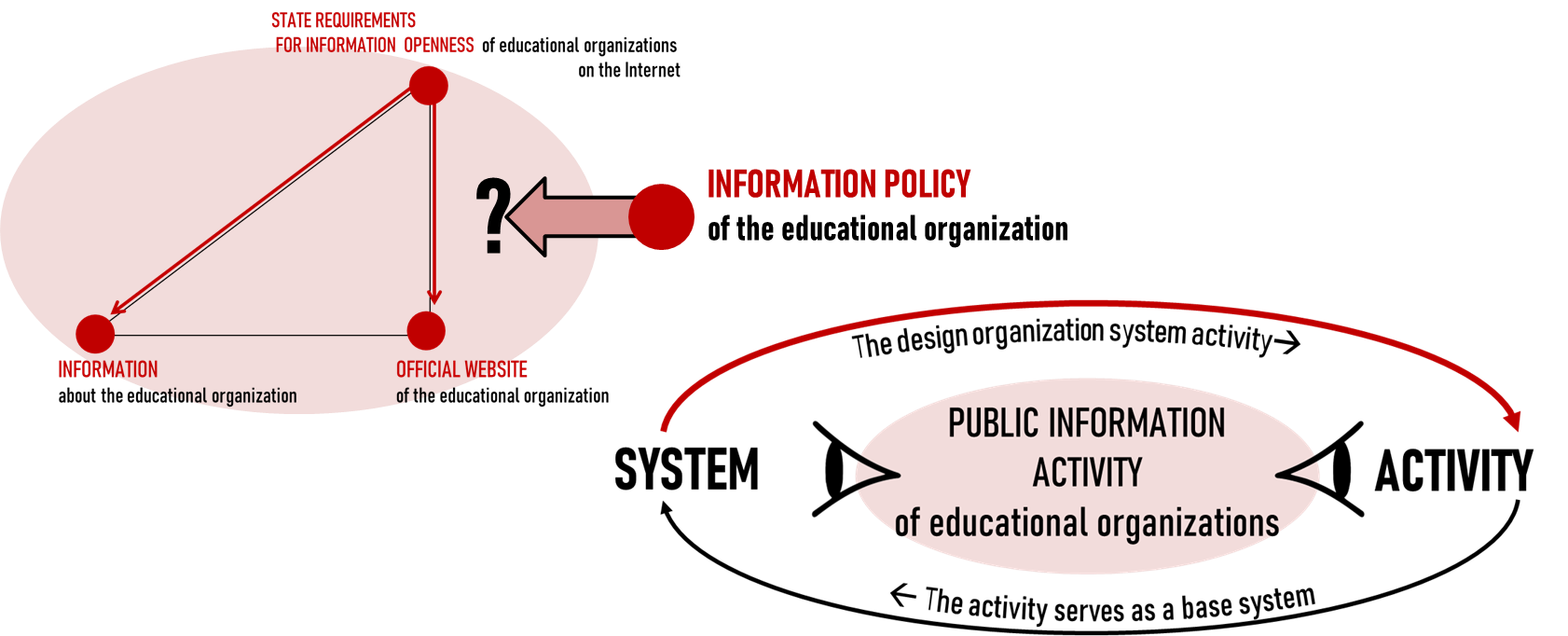
As a starting point of the design of the system was used the idea of Sagatovsky (1981) about the backbone system, generation system and causing factors, which are necessary and sufficient for the emergence and existence of the object.
This provision gives the basis to allocate in the system of public information activities the following elements:
- information about the educational organization as a system element;
- information openness of the educational organization as causing a system element, since it acts as a factor pushing the system requirements defined activities (not only the state requirements for transparency, but also social needs in the education system openness);
- information policy as a system generating element corresponding to the system of public information activities for its target state, which V.N. Sagatovsky considered it as a factor generating system.
In the process of public information activities of educational organizations are various sites on the Internet, which are, on the one hand access to sources of public information on the activities of educational institutions. On the other hand, it is through their sites educational organizations solve the problem of information openness. So, sites are resources solutions of informational transparency problems. On the third hand, the number and quality of sites as the sources and resources of a wide informing the public about the activities of educational institutions is a measure of the effectiveness of the information policy, which chooses the educational organization.
Thus, as an initial embodiment of the hypothesis for the inclusion of information policy element in the system of public information activities of educational institutions was formed following an idea of its structure (figure
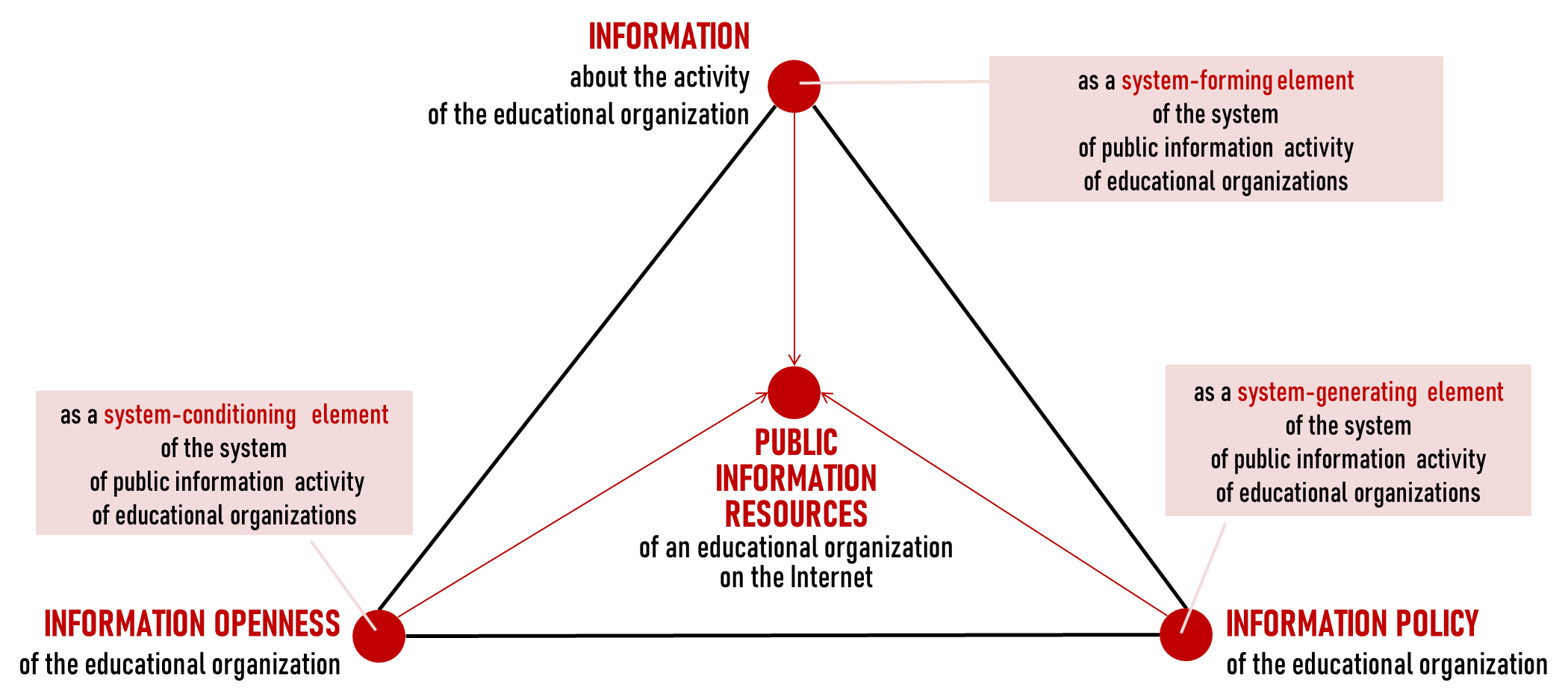
When considering the composition of the necessary and sufficient elements of the system of public information activities of educational institutions, it became clear that this system needs to include another very important element that is associated with information about the educational organization. Information about the educational organization's activity can not exist "alone", and it has its social mission as public information enables communication in the society, public and professional communities.
At the same time, society itself, to access information on the activities of educational institutions, and professional education community have a certain level of culture. In particular, information culture as a culture of handling information communication and culture cooperation (figure
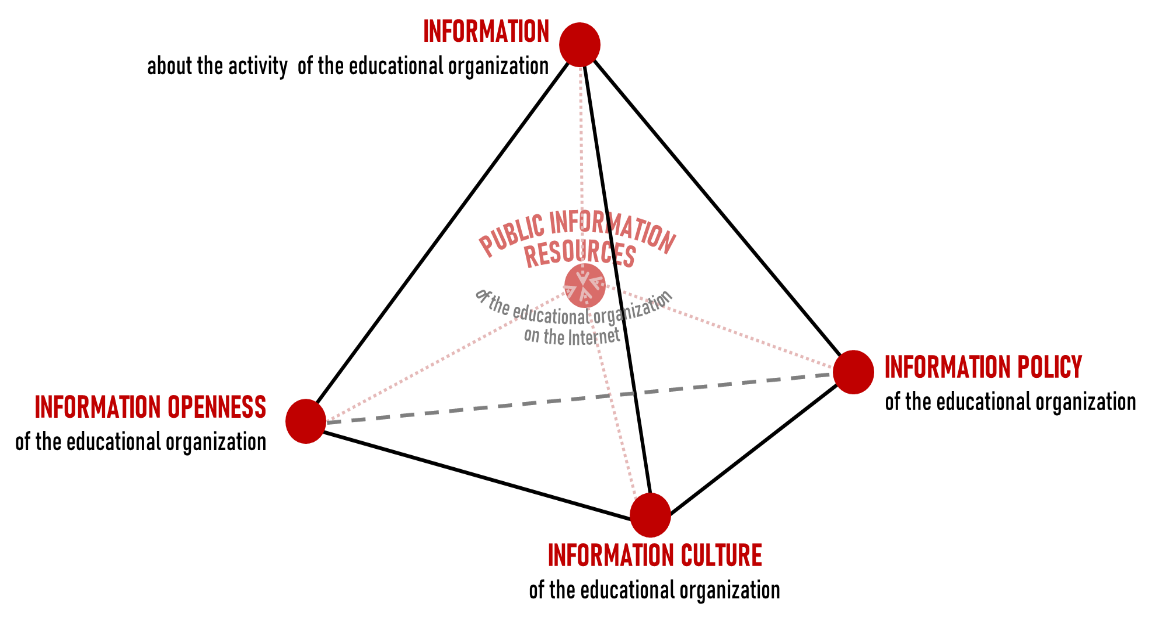
Information culture in the system of public information activities of educational institutions is connected not only with information but also with the information policy. A number of researchers share this view. In particular, Fedotov (2003) in his dissertation study argues that the information culture is the basic foundation of information policy.
Interconnection of information culture and information transparency in the system of public information activities of educational institutions allows you to emphasize the modern and actual direction, according to which the process of forming the image of the educational institutions in the public space of the Internet.
Thus, the integrity of the system of public information activities of educational institutions stipulates the possibility of allocating the most important strategic directions of formation of information policy. The development of this issue is related to two methodological grounds.
The first is the understanding of the system structure as the foundation of the system behaviors. This, according to Meadows (2008), is the essence of the system approach. She believes that if we are able to establish the relationship between structure and behavior, then we begin to understand how the systems work, why they produce certain results, and how to change the behavior so as to achieve better results. It is this type of thinking allows the real causes of the problems and find ways to resolve them: “…it’s the central insight of systems theory. … Once we see the relationship between structure and behavior, we can begin to understand how systems work, what makes them produce poor results, and how to shift them into better behavior patterns. It is a way of thinking that gives us the freedom to identify root causes of problems and see new opportunities” (Meadows, 2008, p. 213).
The second methodological base is the positioning of the information policy as a generating element in the system of public information activities of educational institutions. This means that it will respond to information policy in this system for any target orientation and content will find other elements in the system of public information activities of educational institutions.
Thus, based on the structure of the public information activities of the system, highlighted the following areas of information policy of the educational organization (figure
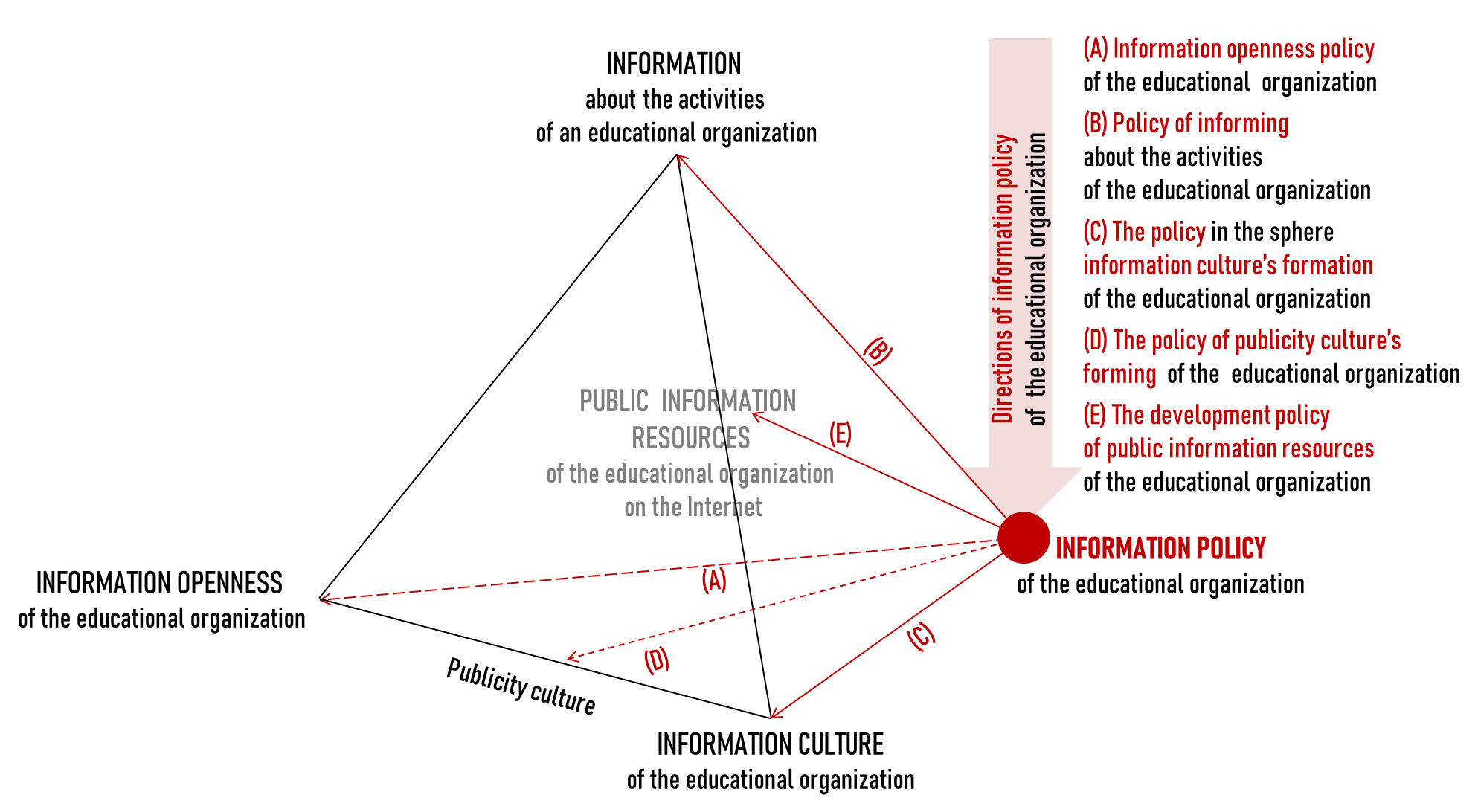
Direction А allows organization to build a policy of transparency, which is invariant in the implementation of educational organization of state requirements for placement on the official website of compulsory for all educational institutions information. Their own conduct information transparency policy, educational organization develops itself on the basis of social and professional needs in the public information on its activities, as well as on their own needs, presenting themselves in the public space of the Internet.
Direction В specifies a policy of information on educational organization and is responsible for the selection of the content and relevance of information. Invariant information policy is the content of the information specified in state requirements as mandatory information about the educational organization to be represented on its official website. Variability component of the policy of informing educational organization defines itself in accordance with its policy of transparency.
Direction С is associated with policy issues in the field of formation of information culture of the educational organization in which important issues are creating a culture of dealing with public information about the activities of the educational organization and the culture of communication users of the information that forms the basis of social dialogue. This area of information policy developed and adopted of the educational organization itself. In the process of developing its policy in the field of formation of information culture the educational organization can take advantage of the best examples of cultural practices and interactive methods of interaction.
Direction D has a direct interface with the policy in the field of formation of information culture of the educational organization, but it has its aspect that distinguishes the policy of forming the public image of the educational organization, which it creates in the public environment, user information about her network "Internet". In other words, it is about building a culture of public educational organizations. This information policy educational organization determines its own. It is about choosing the solution to the problem as a discrepancy between the ideal image and the public image, which is currently formed by means of public information resources that are created in the educational organization.
Direction E forms a complex policy issues of information when deciding which educational organization creates and develops its information presence in the Internet. This direction determines the policy of the educational organization in the development of their public information resources on the Internet. Invariant here is the official website, which is in accordance with state requirements must be for each educational organization. Formats of variant features of public information resources are very broad. Educational organization can develop and encourage the creation of personal websites of individual and collective actors (teachers, sites pre-school groups, classes, groups of children additional education, teacher associations sites, etc.), thematic websites on various activities. Educational organization can combine it creates public information resources in information portal as a common entry point into the public information space of the educational organization.
Thus, the proposed approach to determining the directions of information policy of the educational organization, based on the structural relationships in the system of public information activities, have systemic signs of integrity and provides the connection between all areas of information policy. This makes it possible to raise public information activities in educational organizations to a new level (figure
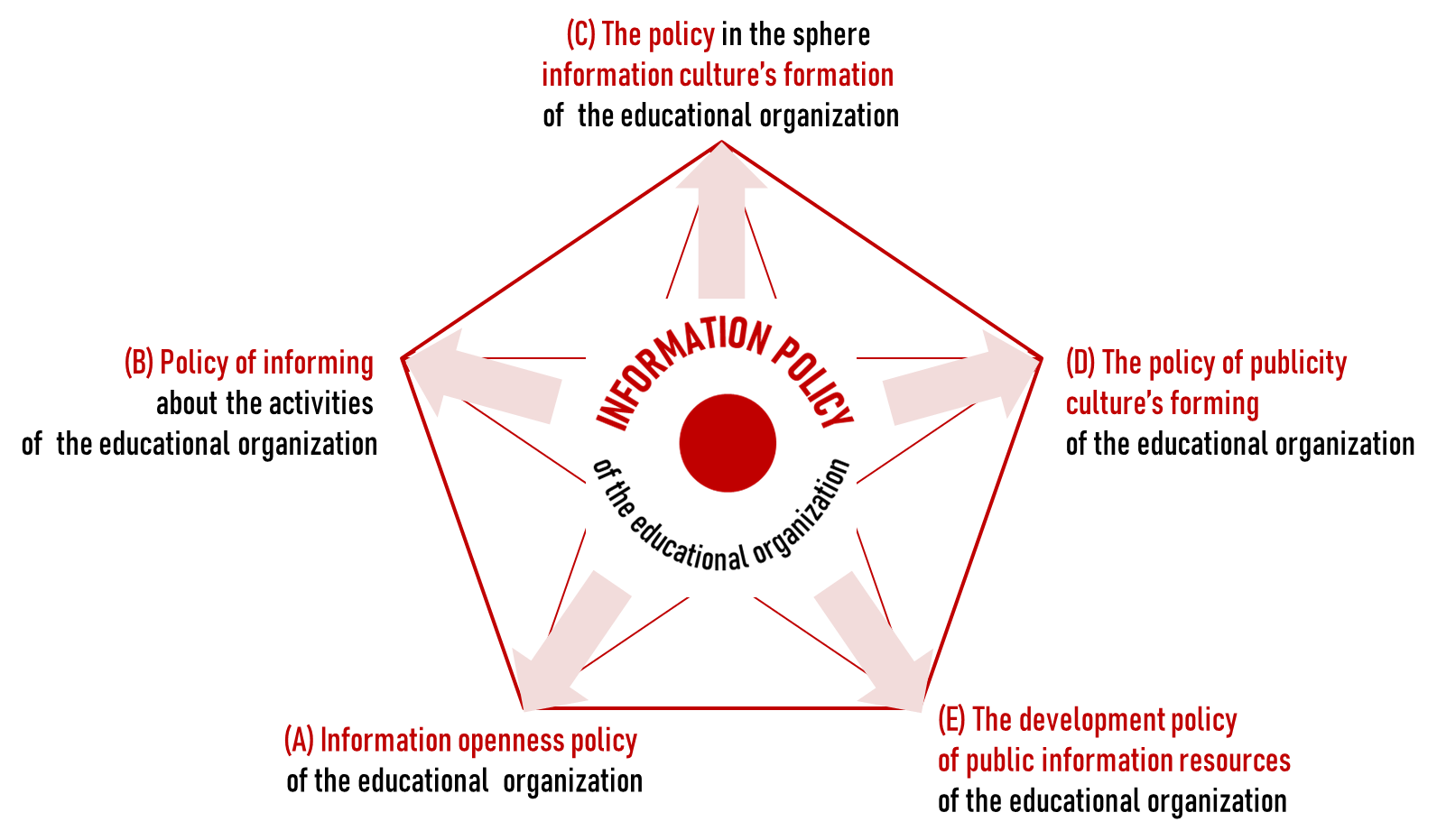
This approach allows us to represent the real situation in practice educational organizations, reflecting the implementation of the information policy of their choice.
The large majority of educational institutions, which management has no idea of integrated information policy, limits the scope of its implementation tasks only information openness. The solution of these tasks carried out by heads of educational institutions exclusively within the framework established by the state requirements to the official website and to the content of information that is mandatory to be represented on the Internet (figure
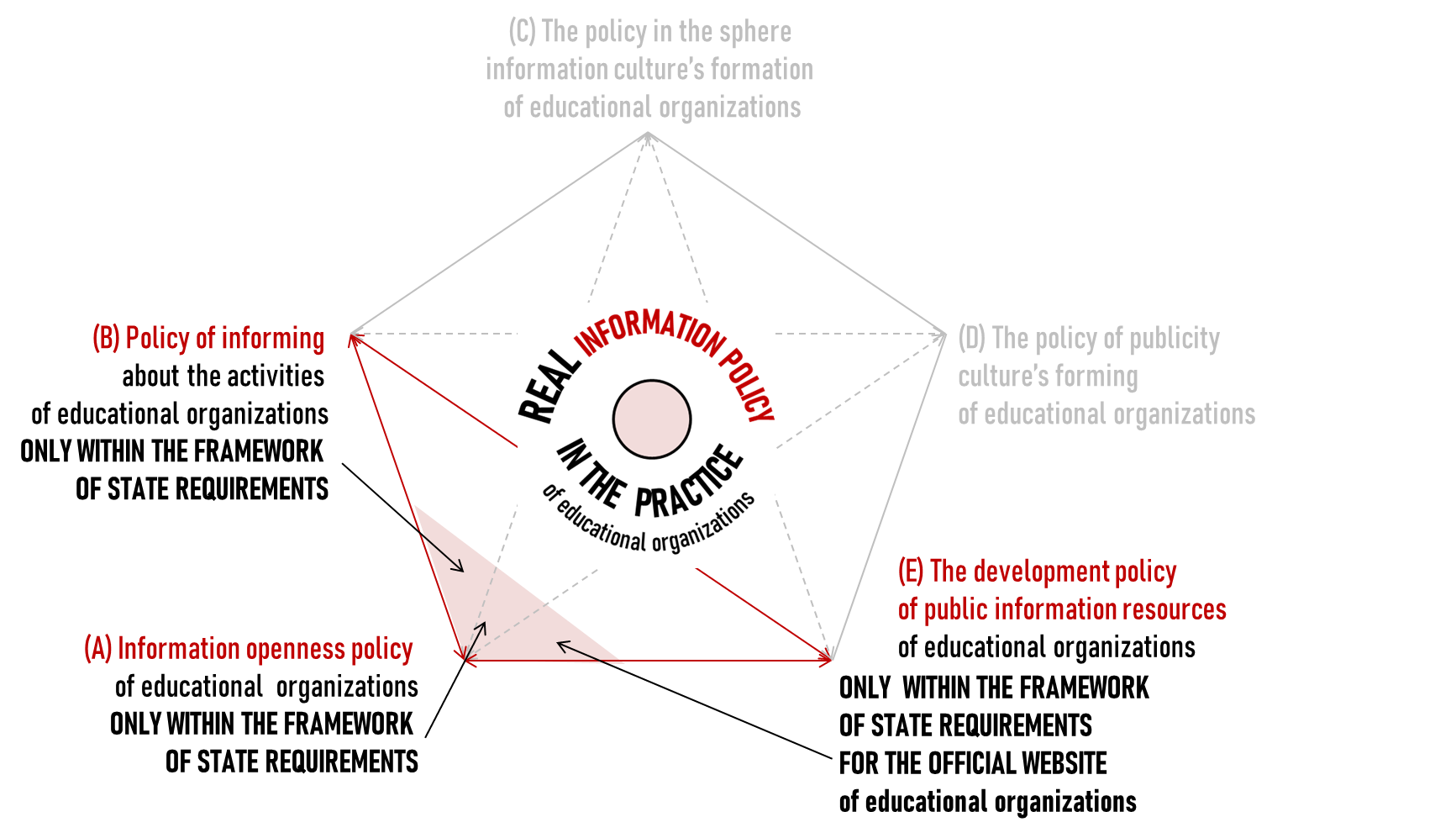
Developed on the basis of this approach, a system of measures aimed at theoretical training and methodological support of the leaders and teachers of educational institutions will contribute to the achievement of the required level of competence in the design and implementation of information policy of the educational organization.
Experience in conducting lectures, seminars and webinars on a given subject, and practice provide methodological support to the development directions and tasks of information policy of the educational organizations in such major areas as the Moscow region and the Chelyabinsk region testify to the effectiveness of the developed approach to the design of information policy.
Conclusion
Despite advances in the solution of a large-scale task of ensuring transparency, in practice, the majority of educational institutions has been a trend towards limiting this problem only fulfillment of state requirements to the official website of the educational placement of regulatory required information about the educational organization.
One of the reasons for this problematic situation, which prevents the expansion of information openness of educational institutions is the lack of theoretical elaboration of new educational institutions for public information activities. This cause, in turn, determines the incompetence in the target orientation and organization of the new activity, which is a source of demotivation heads and teachers of educational institutions for the implementation of this activity.
Search for ways out of this situation led to the study of public information work as a system with a methodological point of system-activity approach. Along with the activity-base system, including the value-semantic, task, process and resource plan analysis of public information activities of educational institutions (Asmolova, 2019), presents an approach to the presentation of this activity as a system.
In contrast to the current practice in the educational systems of many organizations, focused only on the fulfillment of state requirements for transparency, as per the framework of public information activities of educational institutions included information policy and information culture, which is the basis of the communication interaction.
Defining the role of information policy as a system-forming element of public information activities of educational institutions, in accordance with the structure of the system identified the main and interrelated areas of formation of information policy in educational institutions.
A holistic view of information policy directions will contribute to changing the mental model and target systems administrators and teachers with regard to public information activities, which they create in their educational institutions.
Acknowledgments
Research carried out in the research work of the Federal Institute of Education Development RANEPA "11.18. Methods for assessing the quality of public information resources of educational institutions", commissioned by the Russian Presidential Academy of National Economy and Public Administration on 2020.
References
- Asmolova, A. M., & Ovchinnikova, N. R. (2019). From information openness to information policy of educational organizations. The European Proceedings of Social and Behavioural Sciences, LXIV, 55-63. https://doi.org/10.15405/epsbs.2019.07.7
- Asmolova, L. M. (2019). Methodological aspects of the information policy in the educational organizations. The European Proceedings of Social and Behavioural Sciencest, LXIV, 46-54. https://doi.org/10.15405/epsbs.2019.07.8
- Fedotov, N. A. (2003). Informacionnaya kultura v sisteme informacionnoy politiki sovremennogo rossiyskogo obshestva [Information culture in the system of information policy of modern Russian society] (Master’s thesis). Moscow State Open Pedagogical University. https://search.rsl.ru/ru/record/01002649095
- Meadows, D. H. (2008). Thinking in Systems: A Primer. https://wtf.tw/ref/meadows.pdf
- O'Konnor, J., & McDermott, I. (2006). The Art of Systems Thinking - Essential Skills for Creativity and Problem Solving. http://bookre.org/reader?file=2261922
- Sagatovsky, V. N. (1981). Sistemnaya deyatelnost i eye filosofskoye osmisleniye [System Activity and Its Philosophical Thinking]. In System Researches. Methodological Problem. Yearbook (pp. 52-68). Moscow, Russia.
Copyright information

This work is licensed under a Creative Commons Attribution-NonCommercial-NoDerivatives 4.0 International License.
About this article
Publication Date
15 November 2020
Article Doi
eBook ISBN
978-1-80296-093-8
Publisher
European Publisher
Volume
94
Print ISBN (optional)
-
Edition Number
1st Edition
Pages
1-890
Subjects
Psychology, personality, virtual, personality psychology, identity, virtual identity, digital space
Cite this article as:
Asmolova, L. M. (2020). Information Policy Of The Educational Organizations On The Internet. In T. Martsinkovskaya, & V. Orestova (Eds.), Psychology of Personality: Real and Virtual Context, vol 94. European Proceedings of Social and Behavioural Sciences (pp. 35-44). European Publisher. https://doi.org/10.15405/epsbs.2020.11.02.5

